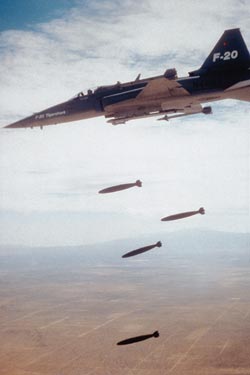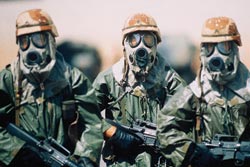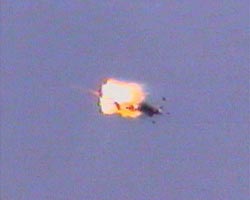Diode lasers are widely deployed as pumps for other lasers, and there are increasing military applications in which the diode laser beam is used directly.
Dr. Paul Rudy, Quintessence Photonics Corp.
Throughout history, military applications have employed state-of-the-art technologies as conflicting parties hastened to stay one step ahead of each another. Photonics technology is no exception. As early as 212 B.C., optics were used as a weapon when, according to legend, Archimedes used large bronze mirrors to direct and focus sunlight, setting Roman ships ablaze during the battle of Syracuse.

Figure 1. Lasers have found a place in high-precision target designation. With increased spatial brightness, diode lasers may become suited for airborne target designation.
In the past several decades, optics and lasers have come to the forefront of military applications and have become as widely deployed and mission-critical as microwave and electronic technologies. A rangefinding demonstration was completed one year after the laser was invented in 1960. And high-precision laser target designation is a common image of modern warfare, shown on the nightly news (Figure 1).
As laser technology evolves toward higher performance and lower cost, size and weight, new military applications are enabled, and existing ones expand in scope. In the past 30 years, laser-based applications such as the laser gyroscope, designator, rangefinder, radar, countermeasures, communications, biochemical agent detection and ordnance initiators have been realized.
Important requirements for lasers in these applications include:
• Light weight and low bulk.
• High efficiency.
• High reliability.
• Operation over a wide range of temperatures.
• Mechanical robustness and low maintenance.
• Low-cost manufacture.
Some applications require a wide choice of output wavelengths and high power or brightness.
Semiconductor lasers are the most compact and efficient types available, and they far exceed gas, liquid and solid-state lasers in meeting a majority of these requirements. The advantages of diode lasers have enabled their deployment in many military applications. Low-power diode lasers, however, have been quicker to gain acceptance in both military and commercial markets than have higher-power models.
Historically, two factors have been barriers to the use of high-power diode lasers. First, their spatial brightness has been inadequate for applications such as directed-energy weapons. Second, diode lasers have not had the innate energy storage required to generate pulses with very high peak powers, so their adoption into applications such as remote sensing lidar has been minimal. Because of their limited spatial brightness and CW nature, high-power diode lasers have not been successful engines for frequency conversion, making them inappropriate for military uses such as mid-infrared countermeasures.
In fact, approximately half of the high-power diode lasers sold today are used to pump solid-state or fiber lasers, which have better brightness, energy storage and spectral reach than diode lasers. Nevertheless, there are direct-diode military applications — that is, those that do not entail diode pumping of another laser. And other military applications have the potential to adopt direct-diode sources as a result of ongoing advances in semiconductor laser technology.
Near-IR lasers
Many military applications involve near-infrared diode lasers. An important class of these uses is active sensing, in which optical energy is transmitted to a target and the returning signal is analyzed to provide information about some physical properties of the target.
Because accuracy and speed are critical in military applications, lasers are uniquely suited for active sensing. Their high directionality maximizes accuracy, unlike radio waves that spread as they propagate. And sensing at the speed of light is a million times faster than doing so at the speed of sound.
To date, the deployment of direct-diode laser sources for active sensing has been for short-range and low-brightness applications such as ranging, illumination and short-range designation. At low (less than 1 W) powers, direct-diode rangefinding lasers gauge distance with high precision by measuring the laser pulse’s round-trip time. Such information can be used for a variety of mission activities, such as dialing in the trajectory of a weapon or determining which weapon to use.
For ranges of less than a few kilometers, direct diodes also have proved to be accurate and reliable for target designation. Short-range target designation enables the remote identification of a target with pinpoint accuracy so that a missile can strike with minimal unintended damage.
Direct-diode lasers with increased spatial brightness may find application in long-range, airborne target designation in the next several years. Well-suited for spotting moving targets, airborne laser designation requires more than 5 W of average power because of the large distance between the aircraft and the target.
Today, this need is met with diode-pumped solid-state lasers, but recent advances in diode technology — motivated primarily by commercial applications such as the pumping of fiber lasers — may change this. Already, 20- to 40-W, conductively cooled, fiber-coupled diode lasers are available on the commercial market. If these lasers can be modified to meet military environmental specifications, and if their brightness can be enhanced, they are likely to replace solid-state lasers for this purpose.
Diode lasers already are mounted on both ground and airborne military vehicles for laser illumination applications. For example, in the US Army’s Lightweight Airborne Minefield Detection system, the laser diodes illuminate a suspected minefield, and the image is captured and analyzed with intensified CCD cameras, lenses, filters and software.
The illuminator comprises a stacked array of diode laser bars in quasi-CW operation at low duty cycle so that the lasers can be conductively cooled. Direct-diode illuminators can contain as many as 100 semiconductor laser diode bars with high-precision fast- and slow-axis collimation and operate with more than 1 kW of peak power and strong polarization purity. The polarization purity is important in applications such as land-mine detection because useful information can be gained by analyzing differences between images obtained with orthogonal polarizations.
Direct diodes also are used in battlefield simulations for training purposes, such as in the Army’s Multiple Integrated Laser Engagement System program. Advanced training techniques use the lasers as a way to conduct live warfare training without firing a bullet. Weapons are outfitted with low-power lasers, and each time a weapon is fired, the pulses of laser light transmit information to a target, including the attacking player’s identification and the type of weapon used. The target processes this information and produces a casualty assessment for the soldier or vehicle for each exchange. In this manner, the battle can be reconstructed and studied in an after-action review.
Mid-IR lasers
Although diode lasers that operate in the 3- to 10-μm mid-infrared have not yet achieved the maturity needed for military applications, they may well do so in the future. There are two applications for which these lasers would be especially well-suited: battlefield communications and the remote detection of chemical warfare agents.
Today, battlefield communications are dominated by radio-frequency technologies, which are vulnerable to detection, jamming and antiradiation munitions. Near-IR free-space optical links at 0.8 to 1.6 μm are relatively immune to these problems but are degraded by fog and smoke and are therefore undependable. Mid-IR radiation in the 8- to 10-μm region is scattered much less by particulates, enabling reliable communications even in foggy and smoky conditions.
The existence of chemical weapons, and the potential willingness of adversaries to employ them, cannot be ignored. It is desirable to provide early warning of chemical weapons with a standoff technique and to reserve the use of personal protective equipment for an attack (Figure 2). Standoff detection of chemical weapons in the atmosphere can be implemented with laser sources tuned to the mid-IR vibrational lines of the target molecules.

Figure 2. Mid-infrared diode lasers enable early warning systems against chemical warfare agents.
The diode lasers that will find application in communications and chemical weapons detection will be compact, have high brightness and cover a wide range of mid-IR wavelengths. Narrow-bandgap, mid-IR diode lasers are being explored in many laboratories. Lead-salt lasers are possible candidates, but they require cryogenic cooling. InGaAsSb and related materials are of interest, but it is difficult to extend their operation beyond 3 μm. In both cases, even at the short-wavelength end of the mid-IR spectrum, these diodes exhibit poor efficiency and low power because of strong Auger recombination, strong intracavity losses and poor carrier confinement.
Quantum cascade lasers offer a potential solution. These lasers generate radiation from transitions between quantum subbands and do not require a narrow-bandgap active layer. Today, however, their performance is below that of standard PN-junction lasers because of their thermal inefficiency and the aggregate strain introduced by fabricating many quantum wells into a device. Quantum cascade lasers today exhibit low wall-plug efficiencies and operate only with short pulses and/or at cryogenic temperatures.
Another approach is a monolithic semiconductor laser device that generates near-IR output and subsequently converts it into the mid-IR with a highly nonlinear III-V compound semiconductor. This technology may be capable of generating several watts of CW mid-IR radiation while operating at or above room temperature.
Further applications
On the low-power end, direct-diode lasers are used to trigger ordnance. Laser initiators have been integrated into complex antimissile interceptor systems such as the US military’s Theater High-Altitude Area Defense and Exoatmospheric Kill Vehicle, designed to destroy incoming long-range ballistic missiles. In these systems, diode lasers provide substantial benefits over conventional igniters.
Laser initiation removes the electrical leads from the explosive material, thereby eliminating the risk of improper or partial ignition by electrostatic discharge or electromagnetic radiation. Ignition is achieved when the diode laser is optically coupled into the explosive. Retrofitting ordnance with laser initiators does not require major changes because the current and voltage needed to drive a diode laser are similar to that of conventional igniters. The lifetime of laser initiators is not an issue, but the environmental specifications are quite demanding.
Another potential direct-diode application involves missile countermeasures. Heat-seeking missiles present a serious threat to ground-based and airborne military vehicles, and recent attacks involving shoulder-fired missiles have underscored the vulnerability of civilian aircraft. Countermeasures such as flares are operationally inflexible and are too easily defeated to meet the demands of today’s environment.
High-power lasers — between 1 and 100 W — in the mid-IR can disable a missile’s sensors. These lasers not only must have high brightness, but also must be wavelength-flexible to prevent an attacker from defeating them by protecting sensors with filters for specific wavelengths. Broad deployment of countermeasure lasers is limited by their cost, size and weight. The development of advanced mid-IR diode lasers may overcome these obstacles.

Figure 3. The US Army’s Tactical High Energy Laser destroyed an armed Katyusha rocket in flight at the White Sands Missile Range in New Mexico in June 2000. The deuterium-fluoride chemical laser detonated the rocket’s high-explosive warhead at a range of a few kilometers. Courtesy of Northrop Grumman Space Technology.
Laser weapons in the 1- to 100-kW class are based on technologies other than direct-diode illumination (Figure 3). Diode-pumping technology is common, however, in these applications. On the low-power side, for example, a multikilowatt, diode-pumped solid-state system mounted on a Humvee was recently deployed to Afghanistan, where it has remotely detonated hundreds of land mines and unspent artillery shells.
Meanwhile, efforts are under way to advance diode lasers to the point where they can be used directly for high-power military applications, significantly reducing system size, weight and cost. Later this year, the Defense Advanced Research Projects Agency will initiate its Architectures for Diode High Energy Laser Systems program in the pursuit of a 10-kW — and, ultimately, a 100-kW — direct-diode source.
Meet the author
Paul Rudy is senior vice president of sales and marketing at Quintessence Photonics Corp. in Sylmar, Calif.; e-mail: [email protected].